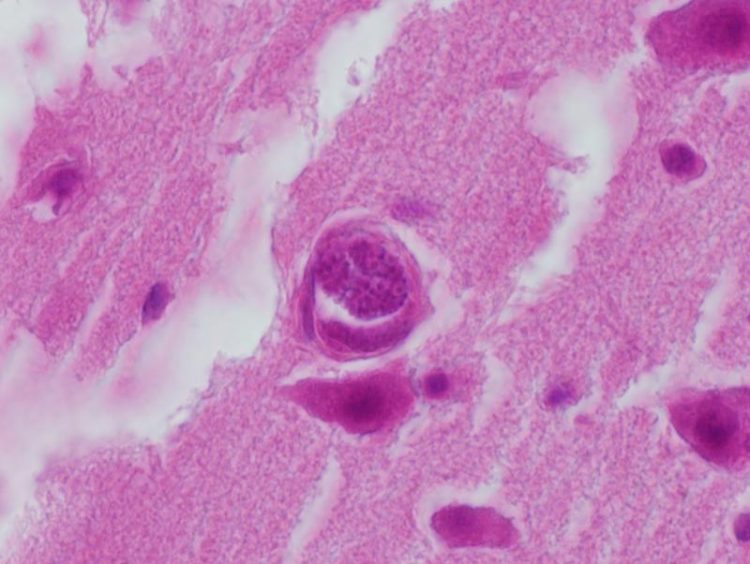Avian malaria also affects wild birds in Austria

Developmental stages of Plasmodium in a blood vessel of the brain, which have led to an almost complete vessel occlusion. Photo: Herbert Weissenböck / Vetmeduni Vienna
In the summers of 2001 and 2004, blackbirds died on a massive scale in Austria. At that time, researchers at the Vetmeduni Vienna analysed more than 600 deceased birds and identified the Usutu virus as the cause of death. The birds had been collected in a regional effort by Austrians and were handed over to the scientists at the Vetmeduni Vienna.
More than ten years later, the researchers tapped once more into the extensive sample material to test the birds that died back then for avian malaria. Until then, only birds kept at Austrian zoos and originating from countries without mosquitoes had been known to be affected by avian malaria. These types of birds at the zoo typically live in Antarctica and the far north, so they have not had the evolutionary opportunity to adapt to avian malaria.
“An infection is life-threatening for penguins at a zoo, for example,” says lead author Herbert Weissenböck. “Native birds have adapted to the blood parasites over evolutionary time. Most of them carry the pathogen, but do not contract the disease. At least that’s what we thought.”
Avian malaria found in 15 percent of the examined birds
The researchers studied organs such as the liver, spleen, lungs and brain of 233 dead birds collected during the regional action programme. They found that some 15 percent of these specimens were infested with Plasmodium to such an extent that their organs were already damaged. Consequently, the researchers assume that the cause of these deaths was avian malaria.
Endemic populations of wild birds, however, are not at risk, believes Weissenböck. “Probably, only a small part of the population consistently dies of avian malaria. This has no dramatic effect on the overall population. But it is a completely new fact that native birds are susceptible at all.”
Three different Plasmodium species identified
Around 100 different Plasmodium species are known to exist. Weissenböck and primary author Nora Dinhopl identified three species in the examined birds: P. elongatum, P. vaughani and a type related to the South American P. lutzi. This new species still needs to be analysed and classified. Surprisingly a fourth subspecies quite frequent in Central Europe, P. relictum, was not present in the dead animals. “It is possible that the P. relictum found thus far does not cause as severe symptoms. We attribute the deaths to the first three subgroups”, Weissenböck reports.
Diagnostic method developed
Weissenböck and his team used a special RNA staining method that enabled them to examine the organs of dead birds. A special stain only binds to parasite RNA in tissue sections and therefore visualizes Plasmodium.
The pathologists want to further refine this method to be able to differentiate individual parasite subspecies. “Malaria is generally diagnosed in blood. Experts can see Plasmodium in red blood cells under the microscope. This was no option for the samples from our archives though. We would like to optimise our RNA staining process for blood samples as well. This would give us a sure-fire method for identifying different parasites in blood too”, Weissenböck emphasises.
Plasmodium decimates mosquitos too
The parasite is also apparently problematic for mosquitos. In a recently published study, Lithuanian partners to the University of Veterinary Medicine Vienna demonstrated that a high load of Plasmodia is also lethal to the insects. (http://link.springer.com/article/10.1007%2Fs00436-013-3733-4). “This is probably one way the mosquito population is naturally reduced every year”, says Weissenböck.
Service:
The article ” In situ hybridization and sequence analysis reveal an association of Plasmodium spp. with mortalities in wild passerine birds in Austria”, by Nora Dinhopl, Nora Nedorost, Meike M. Mostegl, Christiane Weissenbacher-Lang and Herbert Weissenböck was published in the journal Parasitology Research. http://link.springer.com/article/10.1007/s00436-015-4328-z
About the University of Veterinary Medicine, Vienna
The University of Veterinary Medicine, Vienna in Austria is one of the leading academic and research institutions in the field of Veterinary Sciences in Europe. About 1,300 employees and 2,300 students work on the campus in the north of Vienna which also houses five university clinics and various research sites. Outside of Vienna the university operates Teaching and Research Farms. http://www.vetmeduni.ac.at
Scientific Contact:
Herbert Weissenböck
Institute of Pathology and Forensic Veterinary Medicine
University of Veterinary Medicine Vienna (Vetmeduni Vienna)
T +43 1 25077-2418
herbert.weissenboeck@vetmeduni.ac.at
Released by:
Susanna Kautschitsch
Science Communication / Public Relations
University of Veterinary Medicine Vienna (Vetmeduni Vienna)
T +43 1 25077-1153
susanna.kautschitsch@vetmeduni.ac.at
http://www.vetmeduni.ac.at/en/infoservice/presseinformation/press-releases-2015/…
Media Contact
All latest news from the category: Life Sciences and Chemistry
Articles and reports from the Life Sciences and chemistry area deal with applied and basic research into modern biology, chemistry and human medicine.
Valuable information can be found on a range of life sciences fields including bacteriology, biochemistry, bionics, bioinformatics, biophysics, biotechnology, genetics, geobotany, human biology, marine biology, microbiology, molecular biology, cellular biology, zoology, bioinorganic chemistry, microchemistry and environmental chemistry.
Newest articles

Bringing bio-inspired robots to life
Nebraska researcher Eric Markvicka gets NSF CAREER Award to pursue manufacture of novel materials for soft robotics and stretchable electronics. Engineers are increasingly eager to develop robots that mimic the…

Bella moths use poison to attract mates
Scientists are closer to finding out how. Pyrrolizidine alkaloids are as bitter and toxic as they are hard to pronounce. They’re produced by several different types of plants and are…

AI tool creates ‘synthetic’ images of cells
…for enhanced microscopy analysis. Observing individual cells through microscopes can reveal a range of important cell biological phenomena that frequently play a role in human diseases, but the process of…





















